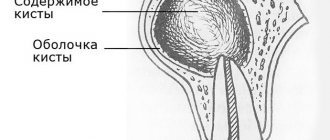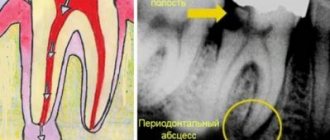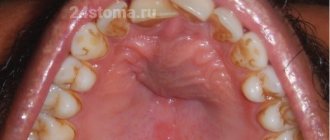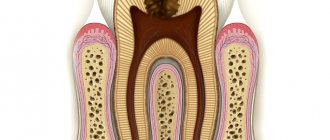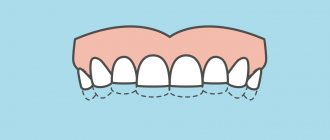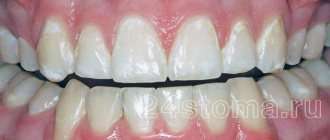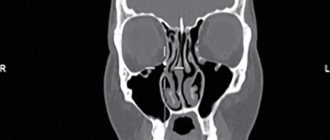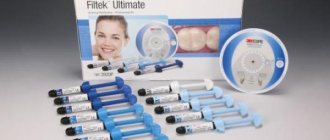Dental granuloma is an inflammatory formation at the apex of the root. It is a proliferation of granulation tissue. Granuloma is formed as a result of the action of protective mechanisms in which the body localizes the source of infection and seeks to isolate it from other tissues. According to ICD-10, the disease was assigned code K04.5.
Typically, a granuloma is formed against the background of inflammation of the neurovascular bundle - the pulp. If pulpitis is not treated, its root part becomes inflamed, and the infection spreads beyond the boundaries of the tooth, into the peri-root tissue. As a result, a kind of pouch is formed, filled with decay products of dead cells.
A granuloma is considered to be a formation up to 0.5 cm in size, but it can grow, and as it grows, it transforms into a cystogranuloma, the size of which reaches 1 cm. With a diameter of more than 10 mm, we are talking about a tooth root cyst. There is no cavity in a granuloma; it is an area of tissue surrounded by a capsule. Due to the latter, the granuloma is firmly attached to the apex of the tooth root.
Granuloma and cyst: what do they have in common?
To summarize, all granulomas are divided into simple and complex. The first type is characterized by a slight compaction of granulation tissue without the release of purulent exudate. Developed forms have a pronounced focus of inflammation and large sizes (up to 10 millimeters in diameter). Some experts do not share the concepts of cyst and granuloma. This needs to be sorted out. A classic granuloma does not have clear boundaries and shape, while a cyst is a capsule with purulent fluid, much larger in size, usually with less pronounced symptoms. On the other hand, a cyst is a developed form of granuloma, i.e., in fact, its more complex type.
How to make an appointment with a dermatologist
You can make an appointment with a dermatologist using the special form “Make an appointment with a doctor” - just enter your data so that the administrator can call you back and coordinate the time of the visit. During the consultation, the doctor will examine the clinical picture, prescribe tests if necessary, and select treatment. You can make an appointment with a dermatologist using the number. JSC "Medicine" (clinic of academician Roitberg) has a convenient location at the address: 2nd Tverskoy-Yamskaya lane, building 10. Nearby there are metro stations: "Mayakovskaya", "Tverskaya", "Novoslobodskaya", "Belorusskaya", "Chekhovskaya" .
How does the treatment of a cyst differ from the treatment of a granuloma?
Many experts distinguish three forms of the disease: granuloma, cystogranuloma and cyst. Depending on the type, a technique is selected and a detailed treatment plan is drawn up. It is believed that the initial form of granuloma can be treated conservatively, and to get rid of the cyst one cannot do without surgical intervention. This statement is partly true, but when drawing up a treatment plan, you must first of all evaluate the clinical picture. A large cyst (more than 8 millimeters in diameter), which affects the roots of healthy teeth, has penetrated the maxillary sinus, caused a serious abscess or osteomyelitis, and must definitely be removed. Granulomas and cystogranulomas of small sizes in the absence of extensive inflammatory processes with the spread of purulent exudate are today quite successfully treated with antibiotics or endodontic manipulations.
Symptoms of a dental cyst
It is practically impossible to recognize the disease at the stage of its inception. The epicenter of development is located deep in the tissues, so it is quite difficult to immediately make a diagnosis. The inflammatory process makes itself felt when external signs or pain symptoms appear:
- darkening of the enamel, redness of the gums;
- pain when biting, pressing;
- itching sensation near the gums;
- discomfort when chewing;
- the appearance of a tugging, sharp piercing pain in the area of the tumor.
During this period of time it is difficult to determine what is happening where. It seems to the patient that this or that tooth hurts - he may mistakenly indicate a healthy one, but in fact, “dead” cells accumulate, and the inflammatory process enters the next stage of development. A purulent formation is formed: the skin is stretched under the pressure of an enlarged, rapidly growing bladder. As the amount of pus increases, the blister grows in size, exceeding 1 cm in diameter. At this stage, the patient’s sensations and appearance make it possible to visually diagnose a dental cyst:
- swelling of the gums, face;
- severe aching pain;
- elevated temperature;
- lack of appetite, malaise;
- statement of the fact of pain in the lymph nodes, their enlargement;
- headache if a cyst appears in the maxillary sinus.
The problem cannot be ignored. The formation of a purulent capsule does not go unnoticed. The process must be kept under control to avoid side effects. We recommend that you consult a specialist when the first, even the slightest, signs of the disease appear. Timely medical care from a dentist helps save the tooth; its results have a positive effect and cause a cosmetic effect.
Tooth granuloma: antibiotic treatment of simple forms of the disease
As already mentioned, granuloma at the initial stage responds well to treatment, since it is only a small nodule of connective tissue. For successful healing, as a rule, it is enough to undergo a course of treatment of dental granuloma with antibiotics. For this purpose, drugs from the group of tetracyclines (Doxycilline), lincosamides (Lincomycin) and penicillins (Amoxiclav) are usually used. The type of drug and treatment concept depend on the degree of pathology and the doctor’s recommendations. It is believed that for the simplest forms of granuloma without visible signs of inflammation, antibiotics in ampoules are prescribed, and to treat granuloma in a more advanced stage, injections are necessary. In addition, the doctor usually prescribes antimicrobial and anti-inflammatory drugs, as well as the use of antibacterial gels and ointments.
Cystotomy
The cystotomy procedure consists of several successive stages.
After drilling out the tooth, the dentist carefully cleans the root canal and removes the pulp. During a very deep cleaning of the canal, the doctor gets to the shell of the cyst and removes its upper part, after which the contents are pumped out of the neoplasm, and the walls of the cyst are treated with disinfectants. Then a special paste is placed into the canal and it is closed with a temporary filling. During subsequent dental visits, tissue healing is assessed. If the tissue heals quickly (which indicates that the infection has been destroyed), then the canals are sealed and a permanent filling is installed.
Treatment of granuloma at home
Can dental granuloma be treated with folk remedies? Yes, but only as an addition to the main therapy. Treatment with folk remedies for granulomas on the root of a tooth usually includes rinsing with various tinctures and decoctions. The most common of them are tinctures of calamus and propolis, decoctions of chamomile and calendula, as well as regular soda solution. Often, the use of folk remedies is prescribed after surgical treatment of cysts and granulomas in order to reduce the inflammatory process and pain in the postoperative period.
PREVENTION
Preventive measures must be carried out in a complex manner. They should be aimed at preventing the occurrence of the disease. Preventive actions include the following:
- Constantly maintaining cleanliness of the oral cavity. That is, this is daily, high-quality cleaning and rinsing.
- Treat bleeding gums.
- Scheduled visit (2 times a year) to the dentist.
- Change your toothbrushes regularly to avoid spreading infections in your mouth.
- The slightest pain in a tooth should prompt the patient to immediately go to the hospital. The process cannot be delayed.
- Pay special attention to diseases such as caries, pulpitis and periodontitis, which are common causes of granuloma.
- Use only medicated toothpastes as a preventive measure.
- Regularly rinse your mouth with herbal decoctions.
- Eat food with the maximum content of calcium, trace elements and vitamins.
Tooth granuloma: treatment of medium forms
To treat advanced forms of granuloma, endodontic techniques are used, which involve opening the root canal cavity. Treatment of diseases at this stage takes several stages and is carried out over a number of visits to the doctor.
Main stages:
- tooth treatment, opening and antiseptic treatment of dental canals;
- antibiotic-based medications are placed into the canal cavity;
- after the required period has expired, the canal cavity is opened again and filled with calcium-containing paste;
- At the final stage, permanent canal filling and tooth restoration are performed.
Separately, it is necessary to mention two modern physiotherapeutic technologies for the treatment of granuloma, which are successfully used in endodontics.
- Depophoresis.
This is cleaning the canal cavity from pathogenic microorganisms using a copper suspension. Under the influence of electric current, the smallest particles actively move throughout the entire canal cavity and destroy the source of inflammation. - Dental microscope.
A very useful and expensive device that allows for the most precise manipulations and provides a more predictable treatment result.
Material and methods
54 patients (36 men, 18 women) aged 18 to 43 years suffering from CGP were examined, of which 19 (15 men, 4 women) were diagnosed with OPGL. The comparison group consisted of 30 patients aged 18 to 45 years living in St. Petersburg and the Leningrad region, examined as part of routine rehabilitation without signs of these diseases.
The study material was the saliva of patients. Saliva collection was carried out in the morning from 9:00 to 10:00. Before collecting saliva, the patient rinsed the mouth with 100 ml of a warm pale pink solution of potassium permanganate. After this, over the next 10-15 minutes, the patient collected saliva in a dry test tube in an amount of about 7 ml.
Salivary content of pro-inflammatory (interleukin-1β (IL-1β), interleukin-6 (IL-6), interleukin-8 (IL-8), tumor necrosis factor-α (TNFα)) and anti-inflammatory (interleukin-1 receptor antagonist ( RAIL), interleukin-4 (IL-4), interleukin-10 (IL-10)) cytokines were determined by enzyme-linked immunosorbent assay using kits according to generally accepted recommendations [19, 20].
Processing of digital data obtained during the survey was carried out using standard methods of variation statistics. Comparison of mean values was performed using Student's t-test. The material was processed on a computer using a specialized package for statistical analysis, Statistica for Windows v. 6.0. Differences between the compared groups were considered significant at p
≤0.05.
Cases where the probability values of the p
were in the range from 0.05 to 0.10 were regarded as “the presence of a trend.”
Laser treatment of dental granuloma
Laser treatment is considered one of the most advanced in medicine and is also used in dentistry. It is believed that treatment of dental canal granuloma with a laser allows you to do without the use of drugs, since the beam destroys the accumulation of granulation tissue and destroys all pathogenic microorganisms. This impact has its supporters and opponents. Fans of laser treatment assure the maximum effectiveness of the technique and provide statistical data demonstrating the effectiveness of this method. On the other hand, the cost of treating dental granuloma with a laser is higher compared to classical endodontic manipulations; the use of certain medications is still required, and in case of non-standard structure of the root canals (in particular, with severe curvature), the use of a laser is less effective. It can also be used during direct surgical intervention in the process of processing and removing tissue. This reduces the invasiveness of the operation, but increases the final cost of treatment.
Available diagnostic methods
At JSC “Medicine” (academician Roitberg’s clinic) near the Mayakovskaya metro station, you can comprehensively examine the health of adults and children. The latest equipment (ultrasound, MRI, CT) and advanced diagnostic methods, specially equipped rooms - everything is there to confirm or refute granuloma annulare in children. In the early stages of development, neoplasms cannot be detected. Symptoms appear when lesions appear on the surface of the epidermis. A diagnostic examination by a dermatologist is carried out when there are complaints of skin changes. Only after this do they turn to laboratory and histological analyzes of skin biopsies from lesions in case of suspicion of deep forms of lesions.
Tooth granuloma: treatment of severe forms
Treatment of complex forms of granuloma, in particular large cysts, is possible only using surgical techniques. The same applies to the treatment of this disease after unsuccessful manipulations that caused numerous perforations of the tooth root. Below are the main granuloma removal techniques.
| Complex granuloma on the root of a tooth: treatment | Description of the technique |
| Cystectomy (apex resection) | The doctor removes the granuloma along with the root tip, after which the canals are filled. Before the procedure begins, it is often necessary to drain the pus, which requires an incision in the gum and a certain time for the fluid to completely drain out (on average 2-3 days). To restore bone tissue in the area of surgery, the use of osteoplastic materials is required. |
| Hemisection | The granuloma is removed along with part of the root and crown, after which the tooth is restored. This is often how granulomas are treated when a tooth canal is perforated. |
| Separation | The technique is applicable exclusively to molars. The tooth is divided into two parts, after which the doctor carries out all therapeutic and restorative manipulations through the resulting gap. |
| Removal of a tooth | An extreme measure that is resorted to when all other methods are impossible for a number of reasons. These include severe damage to the tooth, as well as numerous perforations or a vertical crack in the root. |
Important:
Treatment of tooth granuloma under the crown requires extraction and subsequent replacement of the orthopedic element. If after treatment of granuloma the tooth hurts and the severe pain does not subside after several days, you should consult a doctor.
Pyogenic granuloma
Pyogenic granuloma is a benign neoplasm of the skin or mucous membranes of a vascular nature. Externally, it is a rounded formation (papule) with a diameter of up to 1.5 cm, bright red, cherry or black-brown in color. The tumor volume is filled with small vessels and capillaries surrounded by connective tissue. The surface is easily injured and bleeds profusely. If the compaction does not reverse spontaneously, surgical treatment (electro-, cryo- or laser coagulation) is indicated.
The etiology of the disease is not fully understood. Presumably develops as a reactive process at the site of microtrauma.
In 75% of cases, the growth of the node begins on unchanged skin. Microtraumas that can lead to the appearance often go unnoticed by the patient. In addition to the fingers and oral mucosa, papules can appear on the skin of the face, the back of the hands, palms, neck, chest, and upper back. In pregnant women, seals form mainly on the mucous membrane of the gums of the upper jaw and the inner surface of the lips. The maximum diameter is 1.5 cm, the average is 6 mm. It has a round or lobed shape, a rich color due to a large number of vessels, a wide base, and less often a short stem. The consistency is soft and elastic. The surface of the papule is easily injured, often eroded or covered with crusts, and may be surrounded by a white border of exfoliated epithelium. The node is painless, because has no nerve endings. Discomfort is caused by the presence of a protruding formation on the arms, neck, shoulders and other parts of the body, which clings to clothing, objects, and produces profuse bleeding when damaged. Having reached a certain size, the papule begins to gradually thicken due to the active development of connective tissue layers up to complete fibrosis. Thrombosis and emptying of blood vessels lead to focal necrosis of pyogenic granuloma. When the causative factor is eliminated, the formation may disappear on its own. Reversal of granuloma may take several months.
Diagnostics
An external examination, dermatoscopy, and histological examination helps the doctor determine the type of neoplasm. Of decisive importance in diagnosis are the appearance of the node, its microscopic structure, as well as other data that help make an accurate diagnosis: the growth rate of the tumor, the presence of provoking factors, the effectiveness of previous treatment, and concomitant diseases. Valuable information can be obtained from:
- Dermatoscopy - examination of the papule in this case allows one to identify signs characteristic of an angiomatous neoplasm (a homogeneous reddish node surrounded by a white rim). As a rule, visual signs are sufficient for differential diagnosis of the disease with a number of benign and malignant pathological changes in the skin that are similar in appearance to botryomycoma.
- Biopsy of the node. Tissue collection for histological examination is often carried out directly during surgery to remove the tumor. Pathomorphological examination reveals the proliferation of capillaries and fibroblasts, and infiltration of the stroma with leukocytes.
Preparing for surgery
Treatment of this disease is reduced to removing the tumor.
We perform the operation if the child is completely healthy. To ensure this, you will need to undergo standard preoperative preparation, which is aimed at:
- assessment of general health;
- identification of possible contraindications;
- prevention of intra- and postoperative complications.
The psychological preparation of the child is also important: explain to the child that the operation is necessary for his health, and we will provide the most comfortable conditions for his stay in the clinic.
The anesthesiologist discusses possible pain relief options with the parents.
Preoperative preparation includes: Plan for examining the child before surgery.
Operation
The specialists of our center understand that any operation, even the most minor one, is stressful for the child. To reduce discomfort during the recovery period, our surgeons prefer minimally invasive interventions. This allows you to reduce the risk of damage to nerve endings, blood vessels and other structures during manipulation, allowing you to significantly reduce pain for the child.
In our medical center, electrocoagulation is used as a method of surgical treatment of pyogenic granuloma. This method allows you to remove pathologically changed tissue quickly, with minimal blood loss. Using an electrode, the seal is cut off from the surface of the skin at the base. The resulting tissue fragment is sent for histology.
Rehabilitation period
“Same Day Surgery” allows the patient to leave the clinic within a few hours after the operation. During this time, parents and their child stay in a comfortable room designed for proper rest.
At the site of the manipulation, a round-shaped wound remains, covered with a dense dark crust. Optimal conditions for epithelization are created under it. The crust cannot be removed until the wound has completely healed, otherwise there is a risk of scar development. This is the only limitation of the postoperative period.
Forecast
In case of an established and confirmed diagnosis of pyogenic granuloma, the prognosis for life and recovery is favorable. Regression of compaction without treatment is observed in every second case. Surgery provides a complete cure, but there is always a risk of relapse. A young papule may appear in the same place where the removed node was located. A persistent course requires a more attentive attitude to the causative factors of the appearance of pyogenic granuloma, and their elimination whenever possible. Prevention methods have not been developed due to the lack of accurate data on the etiology of the disease; Injury to the skin and mucous membranes should be avoided and dermatoses treated in a timely manner.
Cost of treatment for surgery to remove pyogenic granuloma
5500 rub.

